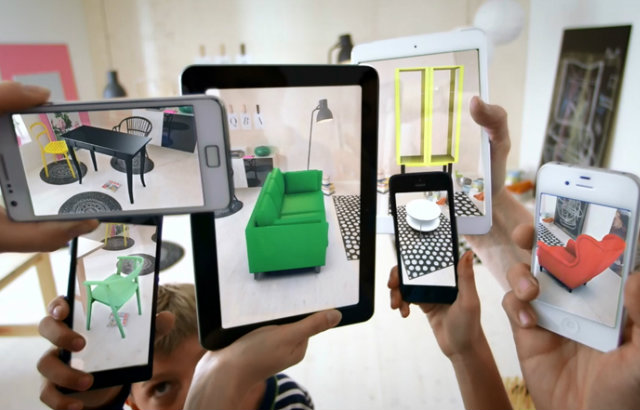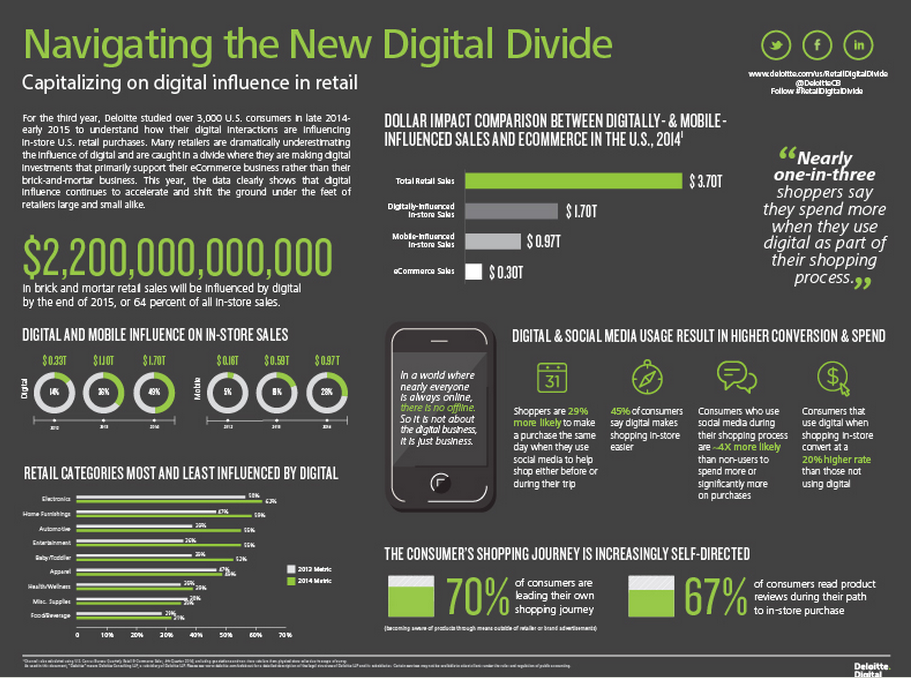
Retail and smartphones, a story of love and hate. It is clear that mobile technology not only affects sales in the 'online territory'; it also has a much broader impact on retail customer experience in general.
The digital transformation involves how we search for product information, what we buy, how when and where. Basically, it changes in-store customer behavior, driving the value of in-store sales. The future lies behind a wave of retail trends transforming the shopping experience.
Since the Internet first entered our home, it was pretty clear that buying patterns were destined to evolve. When mobile connections and - above all - the smartphone were added to the equation, the behavior of retail customers changed forever. And so did the very idea of ‘store’.
All studies highlight the evidence that the traditional physical store we grew up with is inadequate to appeal empowered customers of the digital era, and to respond to the challenge of e-commerce.
Yet retailers are “dramatically underestimating the influence of digital and are caught in a divide where they are making digital investments that primarily support their e-commerce business rather than their brick-and-mortar business.”
A truth stated by ‘Navigating the new digital divide’, a survey conducted by Deloitte Digital to understand how customers engage with digital when shopping, and to quantify how these interactions influence retail customer experience.
“Digital influence – that is, the degree to which in-store sales are influenced by digital at some point in the shopping journey – is growing at an increasing pace. We are fast approaching a day when we can assume 100 percent of shoppers will be connected 100 percent of the time.”
As a consequence of digital disruption, a one-sided approach to retail marketing strategy is potentially catastrophic for your business; it is like randomly walking blindfolded. An omni-channel approach (mobile-first) is the only adequate move: a complete digital customer journey rather than separate e-commerce and physical retail experiences.
Only on the surface traditional retail and online retail are two different things. They’re just the two sides of the same business coin, caught in the maze of evolution. Check the following numbers from the same research:
- 64% of all in-store sales will be influenced by digital by the end of 2015;
- 33% of customers say they spend more when they use digital as part of their shopping experience;
- Customers are 29% more likely to buy the same day when they use social media during their journey;
- Customers engaged with social media while shopping are 4x more likely to spend more;
- 45% of customers say digital is essential to make in-store buying easier;
- 67% of customers look for info and read product reviews on their way to the store.

For decades, the core of retail growth strategy revolved around promotion, place and price. But that was before the mobile mind shift came in to shake up the rules of shopping. We live now an era of rapid technological advancement, with Internet and mobile devices as catalysts for a massive change in the retail & consumer goods industry.
They have changed the industry with a much deeper impact than most retailers actually understand, and over the next ten years there is going to be more change than in the last fifty. What kind of change? Here we outline 10 major paths of evolution that will define the future of retail.
MILLENNIALS POWER
There is no doubt that millennials are critical to decide who wins (or lose) the retail brand challenge. As native digital citizens, they grew up with smartphone, social media and e-commerce. Millennials are the most powerful force in Western economies: their 2015 spending is estimated to be between 1 and 2.45 trillion dollars. Successful retail will be experience-driven retail, across all touch points and channels.
MICRO MOMENTS
Over the last few months, Google released a research that has major implications for brands wanting to succeed in the mobile landscape. Well aware of the impact of the smartphone - in 2015 mobile searches surpassed desktop searches - Google wants you to fragment customer’s life into micro moments, driven by specific intents. That means your traditional marketing funnel is outdated and inadequate to engage the new customer.
MOBILE JOURNEY
Mobile devices and mobile apps become mandatory to map your customer journey in the digital era. Only then you will be able to identify all critical touch points your clients go through when connecting with your brand and products. Customer journey mapping will ultimately help you to identify areas for improvement and establish the appropriate technology to improve the experience across all stages of the life cycle.
SOCIAL COMMERCE
Forget the store, forget the e-store: the next battleground for innovative retailers is called social commerce. Right now people spend more time on Facebook & Co. than on any other site; they use social connections to talk with friends, search for information and share opinions about brand and products. ‘Buy buttons’ already show up on your news feed, and soon we may all buy tapping on a Pin, an image, a featured post or a tweet.
INTERNET OF THINGS
Now that the Internet connects not only people but also objects, the retail customer experience is going to withstand a major upgrade. The Internet of Things can be considered the extreme frontier in connecting customers’ entire physical life to the digital world. This further evolution will have two major effects on retail business: change the way companies create, distribute and sell their products; change the way customers experience the store.
PROXIMITY MARKETING
One side effect of the convergence between the Internet of Things and the spread of mobile devices is the dawn of a new way to connect with customers. It is called proximity marketing and leverages technology to engage clients when they are near or inside the physical store. The iBeacon is one perfect tool to deliver context-aware contents, engage with customers and personalize the shopping experience.
MOBILE PAYMENTS
While we won’t say goodbye to paper cash anytime soon, it was inevitable that mobile technology would also change the way we pay for the things we buy. Customers are moving away from traditional cards, eager to embrace new means of payment. Bitcoins, social transactions, wearables and the Apple Watch pave the way for the future of banking and financial services.
VIRTUAL REALITY
The key to deliver an amazing digital customer experience is to harness the enabling power of technology, focusing on customers’ needs. Virtual reality and augmented reality, in this perspective, are perfect to create an immersive new level of reality, engaging customers with gamification dynamics, supporting the purchase decision, and enhancing the experience (i.e. Neosperience Showroom).
All in all, most purchase decisions happen in front of a screen (mostly a smartphone screen) rather than in-store. Deal with it and rethink your marketing and engagement strategy, capitalizing on digital influence to improve retail customer experience.
YOU MIGHT ALSO LIKE: Retail Marketing Strategy: 5 Steps To Renew Customer Experience
To help you ensure a strategic advantage to your organization, learn about the DCX 7-Steps Checklist crafted by Neosperience, with requirements and insights for a successful digital transformation.



 Your magnifing glass to deeply understand your users and increase the value of each relatonship.
Your magnifing glass to deeply understand your users and increase the value of each relatonship. Listen to the voice of your customers deeply to understand what they truly want.
Listen to the voice of your customers deeply to understand what they truly want. The Lead Generation Platform to get leads from anonymous traffic on your website.
The Lead Generation Platform to get leads from anonymous traffic on your website.  Understand the behavior of people in physical spaces and monitor safety requirements.
Understand the behavior of people in physical spaces and monitor safety requirements. The Digital Commerce Platform designed to follow the most modern technological standards..
The Digital Commerce Platform designed to follow the most modern technological standards.. The XReality platform to tell brand and product stories by connecting physical and digital worlds.
The XReality platform to tell brand and product stories by connecting physical and digital worlds. Points, rewards, levels, badges, missions: a world of nudges to nurture your customer community.
Points, rewards, levels, badges, missions: a world of nudges to nurture your customer community. Discover all the other solutions!
Discover all the other solutions!









